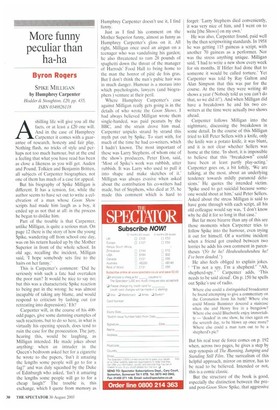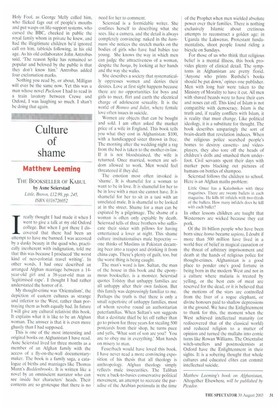More funny peculiar than ha-ha
Byron Rogers
SPIKE MILLIGAN by Humphrey Carpenter Hodder & Stoughton, £20, pp. 435, ISBN 0340826118 Ashilling life will give you all the facts, or at least a £20 one will. And in the case of Humphrey Carpenter it comes with a guarantee of research, honesty and fair play. Nothing flash, no tricks of style and perhaps not too much humour, but at the end a feeling that what you have read has been as close a likeness as you will get. Auden and Pound. Tolkien and Benjamin Britten, all subjects of Carpenter biographies, not one of them has much of a case for appeal.
But his biography of Spike Milligan is different. It has a tension, for, while the author seems to have set out to write a celebration of a man whose Goon Show scripts had made him laugh as a boy, it ended up as not that at all: in the process he began to dislike him.
Part of the trouble is that Carpenter, unlike Milligan, is quite a serious man. On page 12 there is the story of how the young Spike, wandering off from school one day, was on his return hauled up by the Mother Superior in front of the whole school. In old age, recalling the incident, Milligan said, 'I hope somebody sets fire to the hairs on her fanny.'
This is Carpenter's comment: 'Did he seriously wish such a fate had overtaken the poor nun? It would be nice to say no; but this was a characteristic Spike reaction to being put in the wrong: he was almost incapable of taking any blame, and would respond to criticism by lashing out (or retreating into depression).' Eh?
Carpenter will, in the course of his 400odd pages, give some damning examples of such reactions, but to do so here, in what is virtually his opening speech, does tend to ruin the case for the prosecution. The jury, hearing this, would be laughing, as Milligan intended. He made jokes about anything: when an intruder in the Queen's bedroom asked her for a cigarette he wrote to the papers, `Isn't it amazing the lengths some people will go to for a fag?' and was duly squashed by the Duke of Edinburgh who asked, 'Isn't it amazing the lengths some people will go to for a cheap laugh?' The trouble is, this exchange, which I quote from memory as Humphrey Carpenter doesn't use it, I find funny.
Just as I find his comment on the Mother Superior funny, almost as funny as Humphrey Carpenter's gloss on it. All right, Milligan once used an airgun on a teenager who was vandalising his garden; he also threatened to ram 28 pounds of spaghetti down the throat of the manager of Harrods' Food Hall to bring home to the man the horror of pâté de fois gras. But I don't think the nun's pubic hair was in much danger. Humour is a morass into which psychologists, lawyers (and biographers) venture at their peril.
Where Humphrey Carpenter's case against Milligan really gets going is in the details of who wrote the Goon Shows. I had always believed Milligan wrote them single-handed, was paid peanuts by the BBC, and the strain drove him mad. Carpenter unpicks strand by strand this myth put out by Spike. To start with, for much of the time he had co-writers, which I hadn't known. The most important of these was Larry Stephens, of whom one of the show's producers, Peter Eton, said, 'Most of Spike's work was rubbish, utter rubbish. It was Larry who used to pull it into shape and make sketches of it.' Milligan was always evasive when asked about the contribution his co-writers had made, but of Stephens, who died at 35, he made this comment which is hard to forget: 'Larry Stephens died conveniently, it was very nice of him, and I went on to write [the Shows] on my own.'
He was also, Carpenter found, paid well by the then scriptwriting standards. In 1958 he was getting 115 guineas a script, with another 70 guineas as a performer. Nor was the stress anything unique. Milligan said, 'I had to write a new show every week for six months. If Hitler had done that to someone it would be called torture.' Yet Carpenter was told by Ray Galton and Alan Simpson that this was par for the course. At the time they were writing 40 shows a year (Nobody told us you can't do that, so we did it!'). And when Milligan did have a breakdown he and his two cowriters at the time were actually two shows ahead.
Carpenter follows Milligan into the nightmare, discussing the breakdown in some detail. In the course of this Milligan tried to kill Peter Sellers with a knife, only the knife was a potato knife, it was blunt, and it is not clear whether Sellers was home at the time. 'In short, it is impossible to believe that this "breakdown" could have been at least partly play-acting.' Carpenter goes on, a bit loftily, 'We are talking, at the most, about an underlying tendency towards mildly paranoid delusions.' He quotes the intended victim. 'Spike used to get suicidal because someone would shout at him,' said Peter Sellers. Asked about the stress Milligan is said to have gone through with each script, all his old colleague would say was, 'I don't know why he did it for so long in that case.'
But far more bizarre than any of this are those moments when Carpenter tries to follow Spike into the humour, even trying it out for himself. Of a wartime incident when a friend got crushed between two lorries he adds his own comment in parentheses `(Ye he he! Heuheuheuheuheu he! I've been deaded.') He also feels obliged to explain jokes. ' "I'm not a spy, I'm a shepherd." "Ah, shepherd-spy." ' Carpenter adds, 'This needs to be said aloud'. On p. 150 he spells out Spike's use of radio.
Where else could a distinguished broadcaster be found attempting to give a commentary on the Coronation from his bath? Where else could Minnie Bannister descend a staircase when she and Henry live in a bungalow? Where else could Bluebottle enjoy immortality — 'deaded' in one show, he rises again on the seventh day, to be blown up once more? Where else could a man turn out to be a shepherd's pie?
But his real tour de force comes on p. 192 when, across two pages, he gives a step by step synopsis of The Running, Jumping and Standing Still Film. The surrealism of this helpful approach, mirror on mirror, has to be read to be believed. Intended or not, this is a comic classic.
But the structure of the book is good, especially the distinction between the preand post-Goon Show Spike, that aggressive Holy Fool. as George Melly called him, who flicked fags out of people's mouths and put wasps on life-support systems, who cursed the BBC, cheeked in public the royal family whom in private he knew, and had the illegitimate children he'd ignored call on him, tabloids following, in his old age. As his old collaborator John Antrobus said, 'The reason Spike has remained so popular and beloved by the public is that they don't know him.' Antrobus added four exclamation marks.
Nothing you read by, or about, Milligan will ever be the same now. Yet this was a man whose novel Puckoon I had to read in a train lavatory between Crewe and Oxford, I was laughing so much. I shan't be doing that again.



























































 Previous page
Previous page